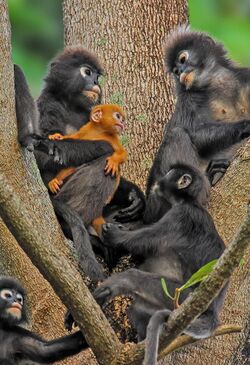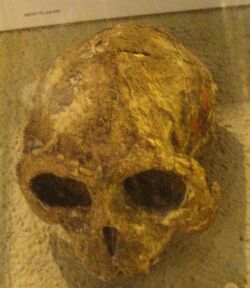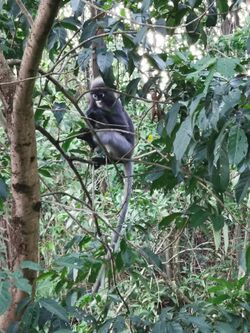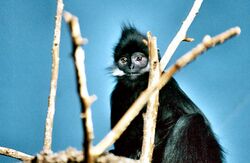Biology:Lutung
| Lutungs | |
|---|---|

| |
| Dusky leaf monkey (Trachypithecus obscurus) | |
| Scientific classification | |
| Domain: | Eukaryota |
| Kingdom: | Animalia |
| Phylum: | Chordata |
| Class: | Mammalia |
| Order: | Primates |
| Suborder: | Haplorhini |
| Infraorder: | Simiiformes |
| Family: | Cercopithecidae |
| Subfamily: | Colobinae |
| Tribe: | Presbytini |
| Genus: | Trachypithecus Reichenbach, 1862 |
| Type species | |
| Semnopithecus pyrrhus [1] Horsfield, 1823
(= Cercopithecus auratus É. Geoffroy, 1812) | |
| Species | |
|
16, see text | |
The lutungs, langurs, or leaf monkeys are a group of Old World monkeys in the genus Trachypithecus (derived from Greek τραχύς, Script error: The function "transl" does not exist. meaning "rough" and πίθηκος, Script error: The function "transl" does not exist. meaning "monkey"). Their range is much of Southeast Asia (northeast India , Vietnam, southern China , Borneo, Thailand, Java, and Bali).
The name "lutung" comes from the Sundanese language meaning "blackness", ultimately from Proto-Austronesian *luCuŋ (which originally referred to the Formosan rock macaque);[2] it is preferred in one paper because the authors wanted the name langurs to only refer to monkeys in the genus Semnopithecus,[3] although some "lutungs" are now "langurs" again.[4][5][6]
Evolution
Genetic analysis indicates that the ancestors of the modern species of lutung first differentiated from one another a little over 3 million years ago, during the late Pliocene. The various species alive today then diverged during the Pleistocene, presumably driven by habitat changes during the Ice Ages.[7] The oldest fossils clearly identified as belonging to the genus date from the middle Pleistocene of Vietnam and Laos; later fossils are also known from Thailand, Java, and Sumatra. The closest living relatives of the lutungs are probably either the gray langurs or the surilis, although the exact relationships remain unclear, possibly due to hybridisation between these genera during the course of their recent evolutionary history.[3]
Taxonomy

As of 2005, the authors of Mammal Species of the World recognize the following Trachypithecus species:[8]
- Genus Semnopithecus
- formerly T. vetulus group - moved into genus Semnopithecus in most recent classifications[9]
- Purple-faced langur, Semnopithecus vetulus
- Nilgiri langur, Semnopithecus johnii
- formerly T. vetulus group - moved into genus Semnopithecus in most recent classifications[9]
- Genus Trachypithecus
- T. cristatus group
- Javan lutung, Trachypithecus auratus
- "Silvery lutung", silvery langur, etc.: Trachypithecus cristatus, but also used for T. germaini
- Indochinese lutung or Germain's langur, Trachypithecus germaini
- Tenasserim lutung, Trachypithecus barbei
- T. obscurus group
- Dusky leaf monkey, Trachypithecus obscurus
- Phayre's leaf monkey, Trachypithecus phayrei
- T. pileatus group
- Capped langur, Trachypithecus pileatus
- Shortridge's langur, Trachypithecus shortridgei
- Gee's golden langur, Trachypithecus geei
- T. francoisi group
- Francois' langur, Trachypithecus francoisi
- Hatinh langur, Trachypithecus hatinhensis
- "White-headed langur", Trachypithecus poliocephalus
- Laotian langur, Trachypithecus laotum
- Delacour's langur, Trachypithecus delacouri
- Indochinese black langur, Trachypithecus ebenus
- T. cristatus group
Since then, the T. vetulus group (the purple-faced langur and the Nilgiri langur) have been moved the genus Semnopithecus based on DNA and other evidence.[4][10][11][12][13][14]
In 2008, Roos et al. described the Malay Peninsula form of the silvery lutung as a separate subspecies and subsequently it has been elevated to a separate species within the T. cristatus group as the Selangor silvered langur, T. selangorensis.[10][15] Roos et al. also elevated the West Javan Langur, Trachypithecus mauritius, and Annamese Langur, Trachypithecus margarita, to species status (formerly subspecies of T. auratus and T. germaini, respectively).[10][15] In 2020, Roos et al. discovered a new species, Popa langur (T. popa), which is found only in Myanmar.[16]
This leaves the current understanding of the genus Trachypithecus to be:
- Trachypithecus cristatus group
- East Javan langur, Trachypithecus auratus
- West Javan langur, Trachypithecus mauritius
- Silvery lutung or silvered leaf monkey, Trachypithecus cristatus
- Selangor silvered langur, Trachypithecus selangorensis
- Germain's langur, Trachypithecus germaini
- Annamese langur, Trachypithecus margarita
- Tenasserim lutung, Trachypithecus barbei
- Trachypithecus obscurus group
- Indochinese grey langur, Trachypithecus crepusculus
- Dusky leaf monkey, Trachypithecus obscurus
- Phayre's leaf monkey, Trachypithecus phayrei
- Popa langur, Trachypithecus popa
- Shan State langur, Trachypithecus melamera
- Trachypithecus pileatus group
- Capped langur, Trachypithecus pileatus
- Shortridge's langur, Trachypithecus shortridgei
- Gee's golden langur, Trachypithecus geei
- Trachypithecus francoisi group
- Francois' langur, Trachypithecus francoisi
- Hatinh langur, Trachypithecus hatinhensis
- Cat Ba langur, Trachypithecus poliocephalus
- White-headed langur, Trachypithecus leucocephalus
- Laotian langur, Trachypithecus laotum
- Delacour's langur, Trachypithecus delacouri
- Indochinese black langur, Trachypithecus ebenus
Physical description
Lutungs have a rather slim build with a long tail. The fur color varies, depending on the species, from black and grey to orange yellow. Many species have skin designs and a brighter lower surface, the hair on the head is often compared to a hood. Their arms are very short in comparison to the feet and their thumbs are also somewhat shorter. The inner surfaces of the hands and feet are hairless so that their fur does not get caught when reaching into branches. These animals reach a length of 40 to 80 cm and a weight of 5 to 15 kg, with males generally larger than females. A bulge over the eyes and other details, primarily in the head, differentiate it from the surilis.
Habitat and distribution
Lutungs live in the forests, often preferring rain forests, although occasionally they are also found in secluded mountain forests. Lutungs are found in South-east Asia and parts of South Asia from India in the west to China in the east.[17]
Behaviour
They spend the largest part of the day in the trees, where they crawl along the branches on all fours, although they can also jump well from tree to tree. They are diurnal, although more active in the early mornings and the afternoon.
They live in groups of five to 20 animals, mostly in harems, i.e. a single male with several females. Young males must leave their birth group when fully mature, often forming bachelor groups. If a new male takes over a harem, defeating and scaring off the harem leader, he often kills the children of the group. Lutungs are territorial, with loud shouting to defend their territories from other lutung interlopers, resorting to force if the outsiders are not scared off. They have a common repertoire of sounds with which they warn group members. Also, mutual grooming plays an important role.
Lutungs are herbivores, primarily eating leaves, fruits, and buds. To digest the tough leaves, they developed a multichambered stomach.
Reproduction
Rarely twins, a typical single birth comes after a seven-month gestation period. Newborns usually have a golden-yellow fur. The mother shares responsibilities of rearing the young with the other females ("aunties") of the harem. They hand the young around, play with it, carry it, and cuddle it, while the mother searches for food. If the mother dies, another female adopts the young animal. Lutungs are weaned in the latter half of their first year, and reach full maturity at 4 to 5 years. The life expectancy is estimated at 20 years.
References
- ↑ Wilson, D.E.; Reeder, D.M., eds (2005). Mammal Species of the World: A Taxonomic and Geographic Reference (3rd ed.). Johns Hopkins University Press. ISBN 978-0-8018-8221-0. OCLC 62265494. http://www.departments.bucknell.edu/biology/resources/msw3/browse.asp?id=12100703.
- ↑ Blust, Robert; Trussel, Stephen (2010). "*luCuŋ: the Formosan rock monkey; Macaca cyclopis". Max Planck Institute for Evolutionary Anthropology. https://acd.clld.org/cognatesets/30116#4/8.58/110.89.
- ↑ 3.0 3.1 Harding, L.E. (2010). "Trachypithecus cristatus (Primates: Cercopithecidae)". Mammalian Species 42 (1): 149–165. doi:10.1644/862.1.
- ↑ 4.0 4.1 Wilson, Don E.; Mittermeier, Russell A.; Rylands, Anthony B. (2012). "Introduction". Handbook of the Mammals of the World, Volume 3: Primates (1st ed.). Lynx Edicions. ISBN 978-8496553897. https://www.lynxeds.com/hmw/introduction/introduction-hmw-volume-3-primates. Retrieved 2018-08-30.
- ↑ Roos, C.; Boonratana, R.; Supriatna, J.; Fellowes, J.R.; Groves, C.P.; Nash, S.D.; Rylands, A.B.; Mittermeier, R.A. (2014). "An updated taxonomy and conservation status review of Asian primates". Asian Primates Journal 4 (1): 2–38. http://static1.1.sqspcdn.com/static/f/1200343/25106535/1403670682630/2014June24_APJ_Vol4_1.pdf?token=EY6Cm%2BAdyf9lSBug8Jv%2BeF%2B%2BPDM%3D. Retrieved 2018-08-30.
- ↑ Karanth, K. Praveen (2008). "Molecular phylogeny and biogeography of langurs and leaf monkeys of South Asia (Primates: Colobinae)". Molecular Phylogenetics and Evolution 46 (2): 683–694. doi:10.1016/j.ympev.2007.11.026. PMID 18191589. http://wgbis.ces.iisc.ernet.in/biodiversity/pubs/ces_pubs/pubs_2008/theme1_08.pdf. Retrieved 2018-08-30.
- ↑ Roos, C. (2008). "Mitochondrial phylogeny, taxonomy and biogeography of the silvered langur species group (Trachypithecus cristatus)". Molecular Phylogenetics and Evolution 47 (2): 629–636. doi:10.1016/j.ympev.2008.03.006. PMID 18406631.[|permanent dead link|dead link}}]
- ↑ Groves, C.P. (2005). "Genus Trachypithecus". in Wilson, D.E.; Reeder, D.M.. Mammal Species of the World: A Taxonomic and Geographic Reference (3rd ed.). Baltimore: Johns Hopkins University Press. ISBN 0-801-88221-4. OCLC 62265494. http://www.departments.bucknell.edu/biology/resources/msw3/browse.asp?id=12100703.
- ↑ Osterholz, Martin; Walter, Lutz; Roos, Christian (2008). "Phylogenetic position of the langur genera Semnopithecus and Trachypithecus among Asian colobines, and genus affiliations of their species groups". BMC Evolutionary Biology 8 (1): 58. doi:10.1186/1471-2148-8-58. ISSN 1471-2148. PMID 18298809.
- ↑ 10.0 10.1 10.2 Roos, C., Boonratana, R., Supriatna, J., Fellowes, J.R., Groves, C.P., Nash, S.D., Rylands, A.B. and Mittermeier, R.A. (2014). "An updated taxonomy and conservation status review of Asian primates". Asian Primates Journal 4 (1): 2–38. http://static1.1.sqspcdn.com/static/f/1200343/25106535/1403670682630/2014June24_APJ_Vol4_1.pdf?token=EY6Cm%2BAdyf9lSBug8Jv%2BeF%2B%2BPDM%3D. Retrieved 2018-08-30.
- ↑ Osterholz, Martin; Walter, Lutz; Roos, Christian (2008). "Phylogenetic position of the langur genera Semnopithecus and Trachypithecus among Asian colobines, and genus affiliations of their species groups". BMC Evolutionary Biology 8 (58): 58. doi:10.1186/1471-2148-8-58. PMID 18298809.
- ↑ Brandon–Jones, D. (2004). "Asian Primate Classification". International Journal of Primatology 25 (1): 97–164. doi:10.1023/B:IJOP.0000014647.18720.32.
- ↑ Xiao Ping Wang (April 27, 2012). "Phylogenetic Relationships among the Colobine Monkeys Revisited: New Insights from Analyses of Complete mt Genomes and 44 Nuclear Non-Coding Markers". PLOS ONE (plos.org) 7 (4): e36274. doi:10.1371/journal.pone.0036274. PMID 22558416. Bibcode: 2012PLoSO...736274W.
- ↑ Karanth, K. Praveen (2008). "Molecular phylogeny and biogeography of langurs and leaf monkeys of South Asia (Primates: Colobinae)". Molecular Phylogenetics and Evolution 46 (2): 683–694. doi:10.1016/j.ympev.2007.11.026. PMID 18191589. http://wgbis.ces.iisc.ernet.in/biodiversity/pubs/ces_pubs/pubs_2008/theme1_08.pdf. Retrieved 2018-08-30.
- ↑ 15.0 15.1 Roos, C. (2008). "Mitochondrial phylogeny, taxonomy and biogeography of the silvered langur species group (Trachypithecus cristatus)". Molecular Phylogenetics and Evolution 47 (2): 629–636. doi:10.1016/j.ympev.2008.03.006. PMID 18406631. https://www.researchgate.net/publication/5445311.
- ↑ Roos, Christian; Helgen, Kristofer M.; Miguez, Roberto Portela; Thant, Naw May Lay; Lwin, Ngwe; Lin, Aung Ko; Lin, Aung; Yi, Khin Mar et al. (2020). "Mitogenomic phylogeny of the Asian colobine genus Trachypithecus with special focus on Trachypithecus phayrei (Blyth, 1847) and description of a new species". Zoological Research 41 (6): 656–669. doi:10.24272/j.issn.2095-8137.2020.254. ISSN 2095-8137. PMID 33171548.
- ↑ Fleagle, John G. (2013). "Asian Colobines". Primate adaptation and evolution (3rd ed.). Amsterdam: Elsevier/Academic Press. pp. 139–144. ISBN 9780123786326. OCLC 820107187.
- Groves, C.P. (2005). Wilson, D.E.; Reeder, D.M.. eds. Mammal Species of the World: A Taxonomic and Geographic Reference (3rd ed.). Baltimore: Johns Hopkins University Press. pp. 175–178. ISBN 0-801-88221-4. OCLC 62265494. http://www.departments.bucknell.edu/biology/resources/msw3/browse.asp.
External links
Wikidata ☰ Q1071167 entry




